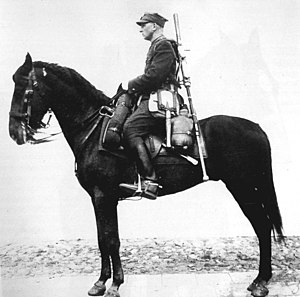Nice! Poland is going to be quite a handful in the Medieval/Industrial eras.
Um... that seems very inaccurate... Poland didn't even exist in that time period, it got wiped out from the map in 1795 and came back in 1918 after a long struggle for independence. Poland never had any kind of Industrial Era units and it was gone for 123 years. During that time the Russians and Germans committed unspeakable atrocities against the Polish civilian population which never gave up and kept fighting the occupants.
Polish Uhlans were professional, Modern Era cavalry soldiers formed after WWI (just in time for WWII).
They were equipped with a 37mm anti tank Bofors cannons.
Anti materiel rifles known as WZ. 35, which could even stop and destroy a Panzer III (but most likely not IV and above).
WZ. 98a - a Polish variant of the Gewehr 98 (essential a longer, German 98k with the same ammunition)
And it wasn't uncommon for some of them to also have a very modern battle rifle (bipod, compensator, select fire mod and pistol grip) known as the RKM Browning WZ. 1928
Think of a Sturmgewehr 44 with a battle rifle round (7,92 × 57 mm Mauser).
Sometimes when they would lure tanks closer to a forest they'd even (supposedly or most likely) use makeshift molotovs to burn German tank engines. Once tanks were in pursuit and entered an area which was perfect for an ambush (usually hills and forests where it was hard for tanks to operate), the shooters with a WZ. 35 would either destroy the panzers with a few shots (around 20mm penetration) but if the frontal armor proved too much they'd shoot the tank tracks, the tank then was immobilized and the tree's (or terrain) made targeting and turning some turrets more difficult (but mainly the best ambush spot was a forest or a thick mist), so once the tank or tanks were unable to move, several Uhlans would get on their horses and throw molotovs at the engine block and the German tank crew was screwed. Even when they tried escaping the burning wreckage the tank crewmen would get stabbed in the head or neck with the spear, sometimes even chopped with a saber because spears and sabers were used by Uhlans instead of bayonets, they were just too impractical and short for cavalrymen. However, the Polish Uhlans were not meant to be "tank killers" and would be unable to go up against Panthers and Tigers, they were more usable in guerilla warfare, hit the enemy hard (preferably in a good spot like the woods or hills) and run unless they could kill an entire enemy unit in one go (which did happen several times, once they killed around 800 German infantrymen in one swoop with very few casualties).
German infantry also didn't have an easy time with Polish Uhlans, the horses made traveling easier without the need for gasoline and the unit was very mobile and loved flanking, as well as fast, sudden attacks, so the Germans always tried to get the Uhlans in the opened field with tank brigades and they did mange to do that a couple of times dealing some casualties but as soon as the tanks started shooting the unit would quickly retreat. Joseph Goebbels later used these Polish Uhlan casualties in a propaganda campaign where it was said that the Uhlans attacked the tanks, charging at them with sabers and spears. This myth was propagated (along with many others) to demoralize the Polish people and the same time boost German morale, there was no talk of actual casualties and losses that the Germans suffered.
Edit:
Hmmm actually... come to think... if the Uhlans could actually do some damage to the Panther and Tiger tanks. Their engines were usually running pretty hot so if they could toss at least one, solid molotov on that engine block or use improvised explosives, the tank wouldn't get completely destroyed but it would be severely damaged and since the ventilation system would suck in smoke and the flaming liquid the crew wouldn't be able to stay in it for long, kinda like when the Americans hit panzers with white phosphorous but if Uhlans had magnetic mines and better anti tank equipment a hit and run tactic against tanks would be far more effective.






 again
again